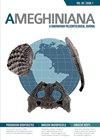阿根廷西北部图库曼省骆驼类动物化石记录
IF 1.5
4区 地球科学
Q3 PALEONTOLOGY
引用次数: 0
摘要
摘要在阿根廷西北部Tucumán发现骆驼类化石已经有很多年了,但是它的相关性到目前为止还没有得到充分的评估。在此,我们回顾了前人对本省骆驼类化石的报道,提出了新的材料,并将其与化石和现存的南美骆驼类标本进行了比较,澄清了其分类背景,讨论了其古生物地理意义。对于Tucumán,我们主要根据大小和牙齿特征识别Vicugna Vicugna (Tafí del Valle组,晚更新世-全新世早期)和Palaeolama sp. (Tucumán组,晚更新世)。骆马目前的分布局限于安第斯山脉中部、海拔3200米以上的普纳和高安第斯山脉环境;无论是现在还是过去,都没有提到Tucumán。在第四纪期间,它在Tafí山谷2200米左右的位置存在,表明条件比目前确定的更冷和更干燥。在这一贡献的背景下所作的观察使我们能够确定,物种V. provicugna是V. vicugna的同义词。因此,我们认为,仅基于颅后遗骨,应该在未来适当地评估该物种的有效性。本文章由计算机程序翻译,如有差异,请以英文原文为准。
The Fossil Record of Camelids (Mammalia, Cetartiodactyla) in Tucumán Province, Northwestern Argentina
Abstract. The presence of fossil camelids in Tucumán, northwestern Argentina, has been recognized for many years but its relevance has not been fully evaluated so far. Here, we review previous mentions of fossil camelids for this province, present new material, and compare it with fossil and extant specimens of South American camelids, clarifying its taxonomic context and discussing its paleobiogeographic significance. For Tucumán we recognize Vicugna vicugna (Tafí del Valle Formation, late Pleistocene–early Holocene) and Palaeolama sp. (Tucumán Formation, late Pleistocene), mainly based on size and dental features. The current distribution of V. vicugna is restricted to the Central Andes, in the Puna and High Andean environments over 3200 m altitude; there is no mention, neither current nor historical, for Tucumán. Its presence at around 2200 m in the Tafí valley during the Quaternary indicates cooler and drier conditions than those currently established. The observations made in the context of this contribution allow us to establish that the species V. provicugna is a synonym of V. vicugna. In turn, we consider that the validity of the species Palaeolama hoffstetteri, only based on postcranial remains, should be properly evaluated in the future.
求助全文
通过发布文献求助,成功后即可免费获取论文全文。
去求助
来源期刊

Ameghiniana
地学-古生物学
CiteScore
2.50
自引率
10.00%
发文量
21
期刊介绍:
Ameghiniana is a bimonthly journal that publishes original contributions on all disciplines related to paleontology, with a special focus on the paleontology of Gondwana and the biotic history of the southern hemisphere. Published yearly since 1957, it has undoubtedly become the main palaeontological publication from Latin America. Ameghiniana has recently broadened its editorial board, reorganized its production process, and increased to a bimonthly frequency, which resulted in a significant decrease in the turn around time.
 求助内容:
求助内容: 应助结果提醒方式:
应助结果提醒方式:


